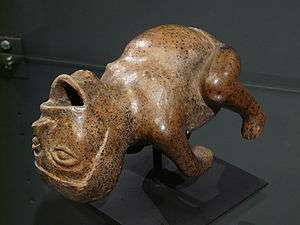Capulí culture

The Capulí culture refers to an archaeological classification for a group in Pre-Columbian South America on the Andean plain in what is now northern Ecuador and southern Colombia. The Capulí preceded the Piartal and Tuza cultures in the archaeological record[1] ranging from around 800 to 1500 CE. The Capulí culture left a strong record through its pottery. The Capulí had distinctive black on dark red pottery with rectilinear geometric designs. The anthropomorphic pottery statues of the Capulí can be striking. Women are depicted with a wrap that extends from the armpit to the ankle while men have loincloths and are often shown with an object such as a drum or animal. These figures are often called coqueros because they are depicted with wads of coca leaves in their mouths. Scholars have associated the figures with shamans and possible funerary rituals.[1]
Capulí goldwork is similar to that of later Ecuadoran and Columbian cultures. Smiths hammered and soldered high-carat gold into geometric and zoomorphic designs.
Capulí graves contained a mix of grave goods including conch shells and stone axes. Some graves in Nariño are extremely deep, as much as 40m. Those Carchi only exceeded 10m in the early Capulí period and were later only 2m deep. Graves were ellipsoid in shape, wider than deep, and burial chambers seem to have been kept open while tunnels were backfilled.[1]

References
- 1 2 3 Peregrine, Peter Neal; Ember, Melvin, eds. (2001). Encyclopedia of Prehistory. 5 : Middle America. New York: Springer,. pp. 167–170. ISBN 0-306-46259-1. OCLC 84088734.